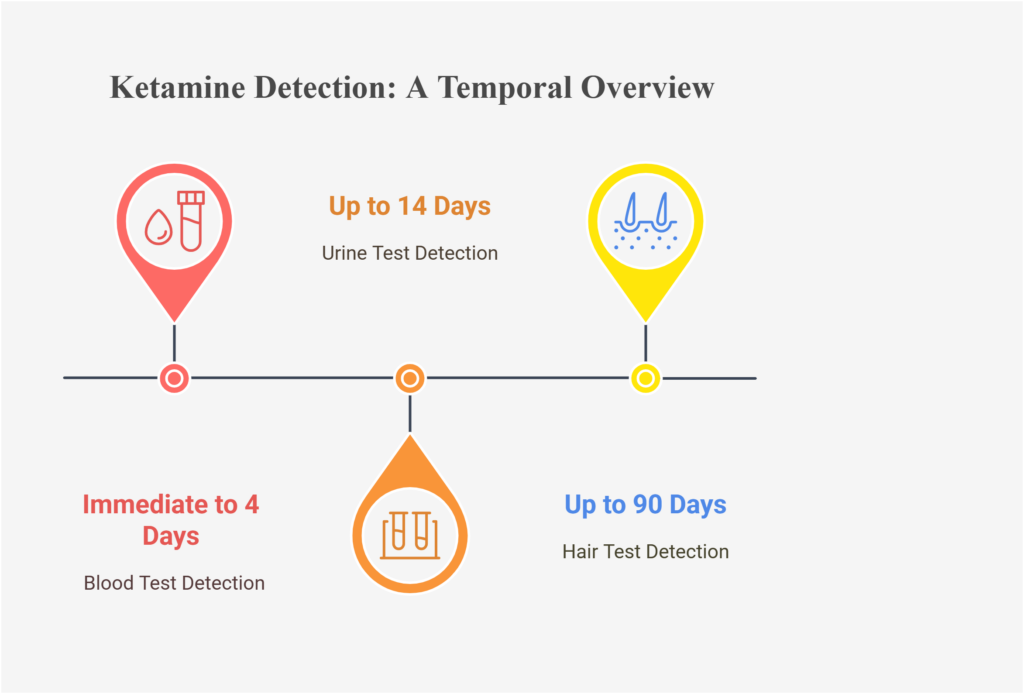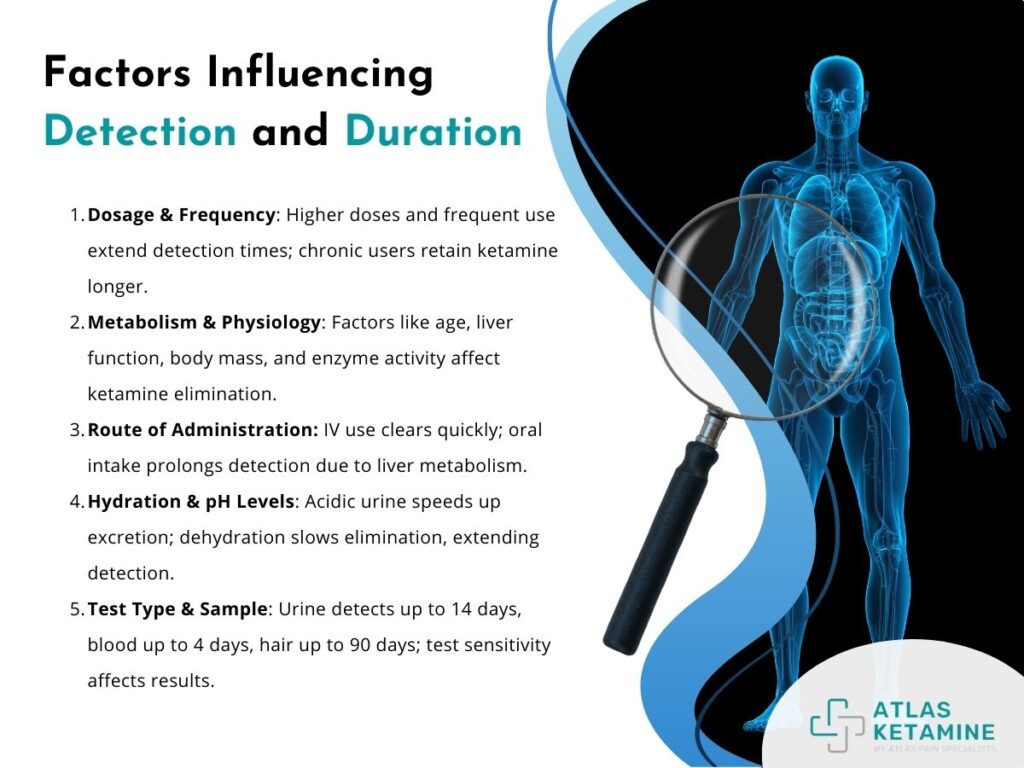Ketamine, a powerful dissociative anesthetic, has gained attention for both its medical applications and recreational use. Understanding how long it remains in the body is crucial for users and healthcare professionals alike.
The duration ketamine stays in the system varies based on several factors, including dosage, frequency of use, and individual metabolism. While the drug's effects may last only a few hours, its metabolites can be detected in urine for up to two weeks and even longer in hair samples. This variability highlights the importance of awareness regarding ketamine's presence in drug testing scenarios. So, how long does ketamine stay in your system?
Pharmacokinetics of Ketamine
Ketamine, a dissociative anesthetic, is widely used for medical, recreational, and therapeutic purposes. Understanding its pharmacokinetics is essential for appreciating its onset, duration, and excretion, which influence its clinical and therapeutic applications.
Half-Life
The half-life of a drug refers to the time it takes for its concentration in the bloodstream to reduce by half. For ketamine, the average half-life is approximately 2.5 to 3 hours. This moderate half-life allows for a relatively short duration of action and a manageable clearance time, making ketamine suitable for procedures requiring rapid recovery.
Metabolism
Ketamine undergoes extensive metabolism in the liver, primarily via the cytochrome P450 enzyme system. It is converted into norketamine, its primary active metabolite, and other secondary metabolites. These metabolites play a role in the pharmacological effects and the extended therapeutic benefits of ketamine, especially in mental health treatments. Excretion occurs primarily through urine, where both ketamine and its metabolites are eliminated.
Duration of Effects
The duration of ketamine's effects varies based on the administration route and dosage. Its unique pharmacological profile ensures rapid onset and distinct phases of impact, ranging from immediate dissociation to a gradual comedown period.
Immediate Effects
Ketamine’s onset of effects is rapid, typically occurring within 30 seconds to 5 minutes after intravenous or intramuscular administration and about 10 to 15 minutes after oral or intranasal use. The peak effects are short-lived, generally lasting 5 to 30 minutes.
During this phase, users experience dissociation, analgesia, and altered perception. The route of administration significantly influences this duration, with intravenous administration resulting in the quickest onset and shortest duration, while oral administration produces a slower onset but more prolonged effects due to first-pass metabolism in the liver.
Comedown Period
The comedown period of ketamine begins as the immediate effects wane, transitioning the user back to baseline consciousness. This phase can last 1 to 3 hours, depending on the dose, individual metabolism, and administration route.
During the comedown, users often report a gradual return to awareness with lingering sensations of euphoria, sedation, or mild disorientation. The comedown is generally less intense than the peak phase, making it easier to manage compared to other dissociative or hallucinogenic substances.
Some individuals may experience residual effects like fatigue, mild headaches, or emotional introspection during this period. These effects are usually mild and dissipate within a few hours.
The comedown experience is influenced by environmental factors, the individual's state of mind, and concurrent substance use. Proper hydration, a calm environment, and rest can help ease the transition from ketamine’s effects back to normalcy.
Detection Times in Various Tests
Ketamine detection in the body depends on factors such as dosage, frequency of use, metabolism, and the type of test employed. Different biological samples—urine, blood, saliva, and hair—provide varying windows of detection, with each method having unique strengths and limitations.

Urine Tests
Urine testing is the most common method for detecting ketamine due to its convenience, cost-effectiveness, and relatively long detection window. Ketamine and its metabolites can be identified in urine for up to 14 days after use, depending on the user's metabolism and frequency of administration.
Chronic or heavy users may exhibit even longer detection times as the drug accumulates in the body. Urine tests are widely used in medical, forensic, and workplace settings, offering high sensitivity to ketamine’s metabolites, particularly norketamine.
Blood Tests
Blood tests provide a shorter detection window compared to urine tests but offer valuable insight into recent ketamine use. Ketamine is detectable in the bloodstream for up to 4 days after use.
The drug's concentration in the blood peaks rapidly following administration, making blood tests ideal for determining immediate or acute exposure. These tests are commonly used in clinical settings, legal investigations, or cases where recent drug use needs to be confirmed. However, their invasive nature and limited detection period make them less practical for routine drug screening.
Saliva Tests
Saliva testing for ketamine is less reliable due to its limited detection capability. The drug is rapidly metabolized and may only be detectable in saliva for a few hours to a day after use, depending on the dosage and method of administration.
While saliva tests are non-invasive and easy to administer, their narrow detection window makes them unsuitable for long-term monitoring or forensic applications. Consequently, saliva testing is rarely employed for ketamine detection.
Hair Tests
Hair testing offers the longest detection window for ketamine, with the drug and its metabolites being traceable for up to 90 days after use. As hair grows, drug residues become embedded in the hair shaft, providing a timeline of drug use.
This method is particularly useful in forensic and legal cases to establish historical ketamine use. While highly effective for long-term detection, hair testing is more expensive and requires specialized equipment, limiting its accessibility and frequency of use.
Factors Influencing Detection and Duration
The detection and duration of ketamine in the body are influenced by various physiological, behavioral, and methodological factors. These variables affect how long the drug remains active and detectable in different biological samples.

- Dosage and Frequency of Use: Higher doses and frequent use of ketamine result in longer detection times. Chronic users may experience accumulation of the drug and its metabolites, leading to extended detectability compared to occasional users.
- Metabolism and Individual Physiology: A person’s metabolic rate significantly influences how quickly ketamine is processed and eliminated. Factors like age, liver function, body mass, and genetic variations in enzyme activity (particularly cytochrome P450 enzymes) play a critical role. Individuals with slower metabolism or impaired liver function may retain ketamine longer.
- Route of Administration: The method of administration (intravenous, intramuscular, oral, or intranasal) affects the onset, duration, and metabolization of ketamine. Intravenous use leads to rapid onset and clearance, while oral administration takes longer due to first-pass metabolism in the liver, potentially prolonging detection.
- Hydration and pH Levels: Hydration levels and urinary pH can influence the excretion of ketamine and its metabolites. Acidic urine may speed up elimination, while dehydration can slow the process, extending detectability in urine tests.
- Type of Test and Sample Used: Different testing methods have varying detection windows. For example, urine tests detect ketamine for up to 14 days, blood tests for up to 4 days, and hair tests for up to 90 days. The sensitivity and specificity of the test also impact the detection period.
Understanding The Science of Ketamine Infusions
Understanding how ketamine works and its duration in the body is essential for those considering infusion therapy. While the immediate effects of ketamine can be felt within hours, its metabolites may linger in the system for days or even weeks, depending on various factors.
This knowledge is crucial for managing treatment schedules and potential drug testing scenarios. As research continues to unveil the complexities of ketamine's action on the brain, it holds promise as a revolutionary treatment for mental health disorders, offering hope where traditional therapies may fall short.
